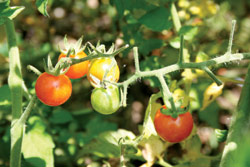Our tomato plants need more sun, less rain and more heat, my mother declared recently. This wasn't news, and she made the observation under gray skies that promised yet another unusually cool summer day. It's rained so much that the plants' identifying tags have been washed clean, and I can't remember what varieties I brought home from the Asheville Spring Herb Festival back in May. It all makes tomatoes (and, for that matter, the whole art of gardening) seem even more mysterious than usual.

Some of the fruits are big, and the plants seem healthy, if a bit too tall due to reaching for an elusive sun. The leaves are vibrant green, the stalks strong. My tomatoes haven't been hit by the damp-induced blight seen on north Georgia tomato farms and thought to be creeping toward Western North Carolina. But they've been decidedly slow to ripen, though one big fruit is now turning yellow (funny: I don't recall selecting such a variety).
"They'd make good fried green tomatoes," said my mom. Indeed, a few weeks earlier she'd picked a few. Sliced, dredged in seasoned cornmeal and pan-fried in one of my cast-iron skillets, they were tasty, although it's a treat I associate with early fall.
Right now, I'm craving ripe tomatoes: Last year, my partner and I planted more than 100 tomatoes — 'Cherokee purple', 'green zebra', 'Williams striped', 'Carolyn's yellow pear' and a few other varieties — at our old mountain farm. The big 'Williams striped' were particularly juicy, delivering old-fashioned beefsteak tomato flavor in a red-and-yellow fruit. This year, however, that old garden lies mostly fallow, awaiting the new owners. Meanwhile, I downsized at our new house in Asheville, putting in a mere three tomato plants.
But back up on the mountain as I readied for the final move later this month, I discovered a surprise: two volunteer tomato plants nestled next to a row of arugula. I've kept an eye on them ever since, pondering which variety they might be.
Last season, this 10-by-10-foot section served as my last-chance garden: At transplanting time, about a dozen tomato seedlings looked too puny to survive the move from greenhouse to garden. Not having the heart to toss them, however, I planted the half-dead zebras, 'Williams striped' and 'Matt's wild cherry' in this little plot. The 'Williams striped' seedlings died, and the zebras ripened late. But the 'Matt's wild cherry' thrived.
I'd also planted a half-dozen of them in the main garden on the mountain, set 18 inches apart in a neat row between stretches of banana peppers and purple-hull peas. The 'Matt's wild cherry' grew like kudzu, overtaking their neighbors and even extending into the outer rows of my 'Principe Borghese' paste-tomato crop. (The seed catalog had mentioned the variety's "vigorous" tendencies.) Well after the first frost, they were still producing clusters of grape-size fruit. When we were doing garden chores or picking veggies, we'd pick some and pop 'em in our mouths for a sweet treat. But much of that fruit grew close to the ground, often hidden in the dense growth (sparrows and rabbits loved hiding in the wild-cherry jungle). And whenever we waded into the green tangle to harvest them, some would fall to earth.
Meanwhile, over in the last-chance plot, the 'Matt's' throwaways did so well that I got tired of picking them and left them to their own devices. So it shouldn't have been a surprise when I bent down to examine those volunteers last week. Barely 2 feet tall, the plants were spreading toward the arugula and clambering over some tatsoi. And looking closer, I spied a cluster of round, green tomatoes that weren't much bigger than the end of my thumb.
Last year, we filled bowls with ripe 'Matt's wild cherry' tomatoes and set them on the kitchen counter. They looked like bright red marbles, except these were a bit sticky and popped sweet in your mouth.
"All right," I mused, "We're leaving the asparagus patch to the new owners. And the blueberries. But if I dig up these 'Matt's wild cherries,' will they survive?"
I'm betting they will. And their wild sprawl, highlighted by tiny but flamboyant fruit, will look good at our new house, in a hanging basket by the kitchen door.
Margaret Williams now gardens in Asheville; you can reach her at mvwilliams@mountainx.com or at 251-1333, ext. 152.



Before you comment
The comments section is here to provide a platform for civil dialogue on the issues we face together as a local community. Xpress is committed to offering this platform for all voices, but when the tone of the discussion gets nasty or strays off topic, we believe many people choose not to participate. Xpress editors are determined to moderate comments to ensure a constructive interchange is maintained. All comments judged not to be in keeping with the spirit of civil discourse will be removed and repeat violators will be banned. See here for our terms of service. Thank you for being part of this effort to promote respectful discussion.